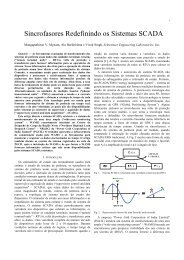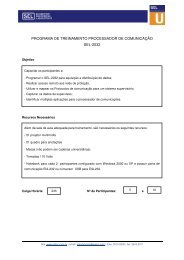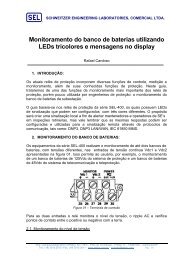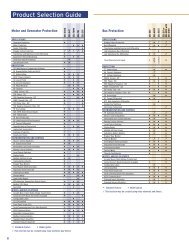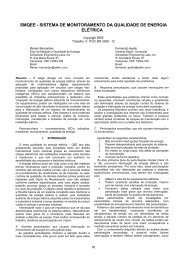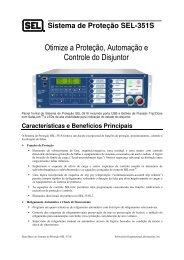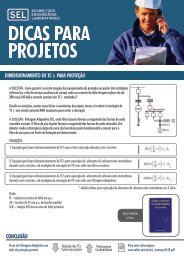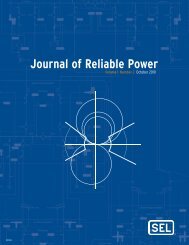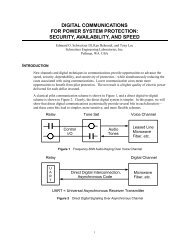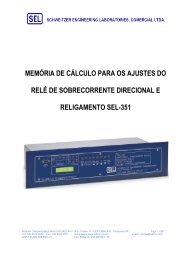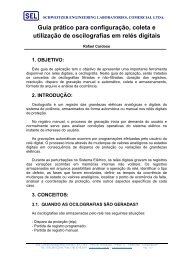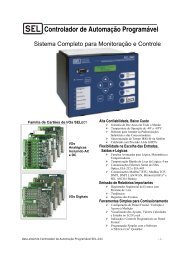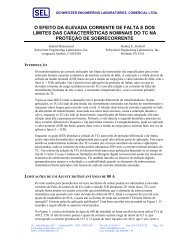Journal of Reliable Power - SEL
Journal of Reliable Power - SEL
Journal of Reliable Power - SEL
You also want an ePaper? Increase the reach of your titles
YUMPU automatically turns print PDFs into web optimized ePapers that Google loves.
increasing security by a factor <strong>of</strong> 10 6 decreased dependability<br />
by a factor <strong>of</strong> 72.<br />
C. Speed<br />
Again consider the 36-bit message developed earlier.<br />
Compared to the two-bit message with a single redundant bit,<br />
it takes 18 times as long to transmit/receive. At<br />
9600 bits/second, it takes about 3.6 ms to transmit/receive the<br />
36-bit message, compared to 0.2 ms for the 2 bit message.<br />
Therefore, increasing security decreases speed somewhat.<br />
D. Adaptability<br />
The 36-bit message developed above gives 10 7 security,<br />
and, when coupled with the proper digital channel, still yields<br />
high speed and excellent dependability. Suppose we use one<br />
<strong>of</strong> the eight data bits for a block-trip signal, and another <strong>of</strong> the<br />
bits for a remote-control direct-trip signal. The security<br />
afforded by the 36-bit protocol is sufficient for blocking<br />
schemes. However, IEC 834-1 recommends ten times better<br />
security for direct tripping. We want to increase the security <strong>of</strong><br />
the direct trip signal without affecting the speed or availability<br />
<strong>of</strong> the blocking signal.<br />
This is easily accomplished with a pickup security counter<br />
on the direct trip bit. For example, a count <strong>of</strong> two requires<br />
reception <strong>of</strong> two successive 36-bit messages with the direct<br />
trip bit set before updating the direct trip bit in the receiving<br />
relay. If we return to the test prescribed by IEC 834-1, we<br />
would still expect to inject 10,000,000 bursts <strong>of</strong> noise, on<br />
average, to get one corrupted message that is incorrectly<br />
accepted by the receiving relay. However, to perturb the<br />
direct-trip bit qualified by a two-count security counter, the<br />
very next message must also be acceptable, and must have the<br />
same direct trip value. This also happens about one in<br />
10,000,000 times. So the probability <strong>of</strong> a false trip in response<br />
to noise bursts is about (10 7 ) 2 or 10 14 . This is six orders <strong>of</strong><br />
magnitude more secure than the IEC 834-1 recommendation<br />
for direct tripping.<br />
Remember we must trade <strong>of</strong>f speed and/or availability to<br />
gain security. Here, the direct trip signal is delayed by one<br />
additional message-time, and the unavailability is roughly<br />
doubled.<br />
E. Practical Implementation<br />
We implemented the 36-bit code described above. The 36-<br />
bit message is transmitted at 19,200 kbits/s in 36/19,200 =<br />
1.875 ms. Allowing for 2 ms <strong>of</strong> latency, plus 2 ms for<br />
processing time in the receiving relay, gives a total <strong>of</strong> about<br />
6 ms from the time the transmitting relay makes a decision to<br />
when the receiving relay has makes a decision influenced by<br />
the transmitting relay.<br />
The delays for a tone set between two relays are much<br />
longer:<br />
2 ms output contact + 12 ms tone set +<br />
2 ms latency + 2 ms processing = 18 ms.<br />
Thus, the direct digital communications gives us eight<br />
times the data with one-third the delay, at far less cost and<br />
complexity.<br />
To test the protocol security, we injected 200 ms long<br />
white noise bursts onto a direct copper connection between<br />
relays. We set the transmitting relay to transmit a known set <strong>of</strong><br />
eight bits, and we set the receiving relay to trigger an event<br />
report upon reception <strong>of</strong> anything but that known pattern.<br />
The receiving relay triggered the first event report after<br />
7 million noise bursts. We terminated the test after 20 million<br />
noise bursts (and nearly 50 days) with still only one<br />
undetected error.<br />
F. Applicability<br />
Since the protocol described above is a simple serial bit<br />
stream, it is compatible with many channels and many types<br />
<strong>of</strong> data communications equipment.<br />
G. Channel Performance Monitoring<br />
Digital communications provide opportunities for<br />
performance monitoring, so the quality can be assessed, and<br />
problems can be quickly detected and remedied.<br />
One channel monitor tallies the time the received data are<br />
corrupted or absent, and normalizes that time to the total<br />
elapsed time. This directly measures the unavailability <strong>of</strong> the<br />
communications. Although unavailability is a useful long-term<br />
measurement, it hides long but infrequent channel<br />
disturbances. For example, suppose a channel monitor is set to<br />
alarm when the unavailability exceeds 500 x 10 -6 . If that<br />
channel is error-free for one year and then the channel is<br />
completely lost, the unavailability monitor will not alarm until<br />
four hours later.<br />
A second monitor can be used to alarm when the channel is<br />
not available for a certain continuous time, say one second.<br />
The unavailability alarm responds to gradual degradations<br />
in bit-error rate. The duration alarm responds more quickly to<br />
outright channel failures.<br />
A sample report from such a monitor follows. It reports the<br />
256 most-recent errors, the average unavailability for the time<br />
<strong>of</strong> the report, and the longest-duration channel outage.<br />
Digital Communications for <strong>Power</strong> System Protection: Security, Availability, and Speed | 31




